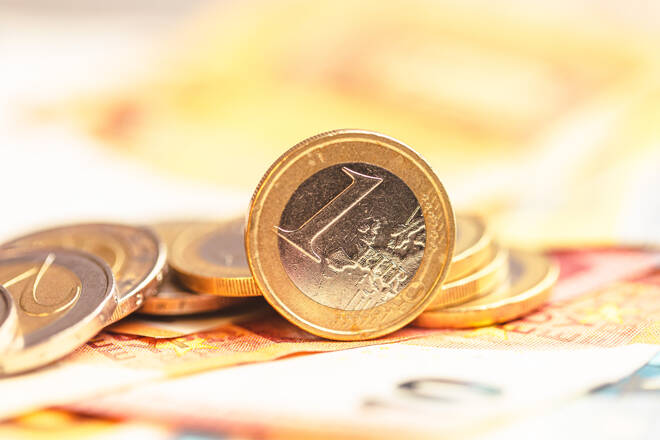Advertisement
Advertisement
EUR/USD Forecast: Unpacking August’s PMI Data and ECB Policy Signals
By:
US services PMI's role in final rate hike debates: Will Powell's speech at Jackson Hole tip USD's balance?
In this article:
Highlights
- EUR/USD falls on Tuesday as mixed indicators cloud ECB’s September moves.
- Private sector PMIs set to reveal pre-Jackson Hole trends.
- ECB’s data-dependent stance amid manufacturing contraction.
Tuesday Overview
On Tuesday, the EUR/USD gave up the gains from Monday, falling 0.46% to end the session at $1.08453. The EUR/USD rose to a high of $1.09304 before sliding to a session low of $1.08328.
Prelim PMIs for August to Deliver Pre-Jackson Hole Trends
Flash private sector PMI numbers for France, Germany, and the Eurozone will draw interest today. Mixed economic indicators have left investors uncertain about ECB monetary policy intentions for September.
The ECB shifted to a data-dependent by meeting stance on monetary policy before the summer break. A more marked contraction across the manufacturing sector and slower activity across the services sector could close the door on a September ECB rate hike.
However, investors should consider the sub-components, including inflation, new orders, and hiring. An increased services sector influence will leave the EUR/USD sensitive to both PMI numbers.
With a busy economic calendar for investors to navigate, ECB commentary will also need consideration. However, no ECB Executive Board members are on the calendar to speak today, leaving chatter with the media to influence.
US Services PMI to Define Dollar Trajectory
The US private sector is also in the spotlight this afternoon. We expect increased market sensitivity to the prelim services PMI. Investors are undecided between a final Fed interest rate hike and an end to the monetary policy tightening cycle.
With investors anticipating the Jackson Hole Symposium and Fed Chair Powell speech, a hotter-than-expected services PMI would raise bets on a September rate hike. Significantly, Fed Chair Powell may have no choice but to spook the markets with a hawkish outlook.
In contrast, a slump in service sector activity would shut the door on one final rate hike and reignite US recessionary jitters. A steady US services PMI will fuel the uncertainty. Economists forecast the US services PMI to fall from 52.3 to 52.2 in August.
EUR/USD Price Action
Daily Chart
The Daily Chart showed the EUR/USD at the lower level of the 1.0900 – $1.0850 support band. After the bearish Tuesday, the EUR/USD sat below the 50-day EMA while holding above the 200-day EMA, sending bearish near-term but bullish longer-term price signals.
Looking at the 14-Daily RSI, the 37.59 reading reflects bearish sentiment. The RSI aligns with the 50-day EMA, signaling a fall through the 200-day EMA to target sub-$1.08. However, a EUR/USD move through the $1.0900 – $1.0850 support band would bring the 50-day EMA into play.
4-Hourly Chart
Looking at the 4-Hourly Chart, the EUR/USD sits at the lower level of the $1.0900 – $1.0850 support band. After the Tuesday loss, the EUR/USD remains below the 50-day and 200-day EMAs, sending bearish near and longer-term price signals.
The 14-4H RSI at 39.23 reflects bearish sentiment, with selling pressure outweighing buying pressure. Significantly, the RSI signals a fall through the lower level of the $1.0900 – $1.0850 support band to target sub-$1.08. However, a break out from the lower level of the $1.0900 – $1.0850 support band would give the bulls a run at the 50-day EMA.
About the Author
Bob Masonauthor
With over 20 years of experience in the finance industry, Bob has been managing regional teams across Europe and Asia and focusing on analytics across both corporate and financial institutions. Currently he is covering developments relating to the financial markets, including currencies, commodities, alternative asset classes, and global equities.
Latest news and analysis
Advertisement
